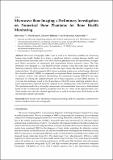| dc.contributor.author | Amin, Bilal | |
| dc.contributor.author | Shahzad, Atif | |
| dc.contributor.author | O'Halloran, Martin | |
| dc.contributor.author | Elahi, Muhammad Adnan | |
| dc.date.accessioned | 2021-03-24T11:48:52Z | |
| dc.date.available | 2021-03-24T11:48:52Z | |
| dc.date.issued | 2020-11-05 | |
| dc.identifier.citation | Amin, Bilal, Shahzad, Atif, O’Halloran, Martin, & Elahi, Muhammad Adnan. (2020). Microwave Bone Imaging: A Preliminary Investigation on Numerical Bone Phantoms for Bone Health Monitoring. Sensors, 20(21), 6320, doi:10.3390/s20216320 | en_IE |
| dc.identifier.issn | 1424-8220 | |
| dc.identifier.uri | http://hdl.handle.net/10379/16628 | |
| dc.description.abstract | Microwave tomography (MWT) can be used as an alternative modality for monitoring human bone health. Studies have found a significant dielectric contrast between healthy and diseased human trabecular bones. A set of diverse bone phantoms were developed based on single-pole Debye parameters of osteoporotic and osteoarthritis human trabecular bones. The bone phantoms were designed as a two-layered circular structure, where the outer layer mimics the dielectric properties of the cortical bone and the inner layer mimics the dielectric properties of the trabecular bone. The electromagnetic (EM) inverse scattering problem was solved using a distorted Born iterative method (DBIM). A compressed sensing-based linear inversion approach referred to as iterative method with adaptive thresholding for compressed sensing (IMATCS) has been employed for solving the underdetermined set of linear equations at each DBIM iteration. To overcome the challenges posed by the ill-posedness of the EM inverse scattering problem, the L2-based regularization approach was adopted in the amalgamation of the IMATCS approach. The simulation results showed that osteoporotic and osteoarthritis bones can be differentiated based on the reconstructed dielectric properties even for low values of the signal-to-noise ratio. These results show that the adopted approach can be used to monitor bone health based on the reconstructed dielectric properties | en_IE |
| dc.description.sponsorship | The research leading to these results has received funding from the European Research Council under
the European Union’s Horizon 2020 Programme (H2020)/ERC grant agreement n.637780. | en_IE |
| dc.format | application/pdf | en_IE |
| dc.language.iso | en | en_IE |
| dc.publisher | MDPI | en_IE |
| dc.relation.ispartof | Ieee Sensors Journal | en |
| dc.rights | Attribution-NonCommercial-NoDerivs 3.0 Ireland | |
| dc.rights.uri | https://creativecommons.org/licenses/by-nc-nd/3.0/ie/ | |
| dc.subject | bone health | en_IE |
| dc.subject | bone phantoms | en_IE |
| dc.subject | compressed sensing | en_IE |
| dc.subject | dielectric properties | en_IE |
| dc.subject | distorted Born iterative method | en_IE |
| dc.subject | microwave tomography | en_IE |
| dc.title | Microwave bone imaging: A preliminary investigation on numerical bone phantoms for bone health monitoring | en_IE |
| dc.type | Article | en_IE |
| dc.date.updated | 2021-03-19T10:30:19Z | |
| dc.identifier.doi | 10.3390/s20216320 | |
| dc.local.publishedsource | https://doi.org/10.3390/s20216320 | en_IE |
| dc.description.peer-reviewed | peer-reviewed | |
| dc.contributor.funder | H2020 European Research Council | en_IE |
| dc.internal.rssid | 25272205 | |
| dc.local.contact | Martin O'Halloran, School Of E&I/School Of Medicine, Nui Galway. 5072 Email: martin.ohalloran@nuigalway.ie | |
| dc.local.copyrightchecked | Yes | |
| dc.local.version | ACCEPTED | |
| dcterms.project | info:eu-repo/grantAgreement/EC/H2020::ERC::ERC-STG/637780/EU/Frontier Research on the Dielectric Properties of Biological Tissue/BIOELECPRO | en_IE |
| nui.item.downloads | 61 | |


